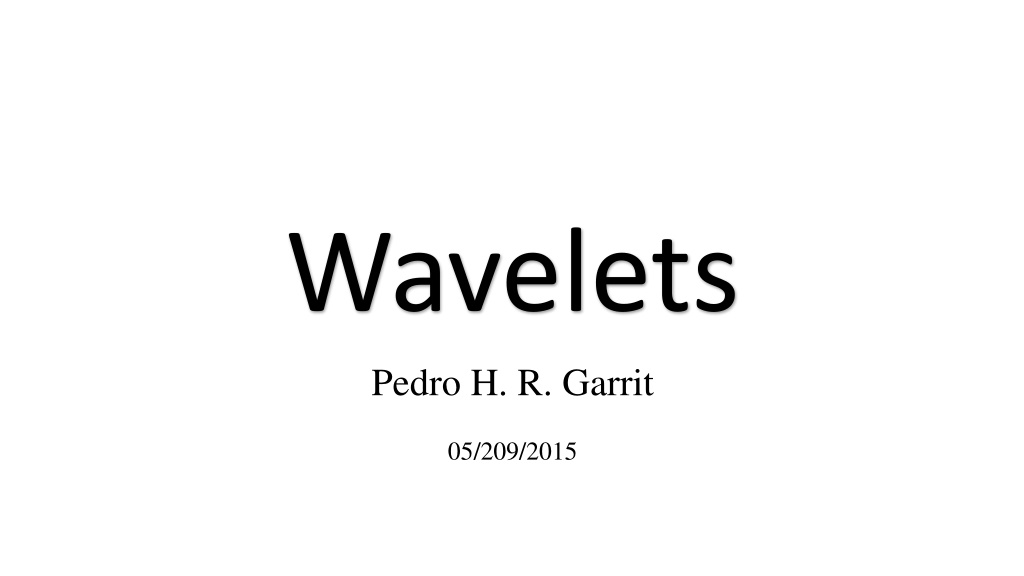Wavelets
This content delves into the MODWPT algorithm and its comparison with PMODWPT, Fourier transform, and other methods in heart rate variability analysis. It explores wavelet variance estimators, time-resolution advantages, feature extraction for EMG pattern classification, and more.
Download Presentation

Please find below an Image/Link to download the presentation.
The content on the website is provided AS IS for your information and personal use only. It may not be sold, licensed, or shared on other websites without obtaining consent from the author.If you encounter any issues during the download, it is possible that the publisher has removed the file from their server.
You are allowed to download the files provided on this website for personal or commercial use, subject to the condition that they are used lawfully. All files are the property of their respective owners.
The content on the website is provided AS IS for your information and personal use only. It may not be sold, licensed, or shared on other websites without obtaining consent from the author.
E N D
Presentation Transcript
Wavelets Pedro H. R. Garrit 05/209/2015
MODWPT (Maximum Overlap Discrete Wavelet Packet Transform) Non-Orthogonal; Has a Higher computational cost than DWT; Does not have a down sampling step; Supports any sample size; Produces a more asymptotically efficient wavelet variance estimator than the DWT;
A new algorithm for wavelet-based heart rate variability analysis Differences between MODWPT (fig.1) and is variation with the pruning algorithm PMODWPT (fig.2). The difference on the number of calculated coefficients shows a decrease on the execution time for PMODWPT in relation to MODWPT being even comparable to the execution time of the typical Fourier transform (Fig .3) Fig.1 MODWPT decomposition tree with the nodes selected to cover the band [0,7/16] Hz (Fs=2Hz). Fig.2 Pruned MODWPT decomposition tree (PMODWPT) with the nodes selected to cover the band [0,3/8] Hz (Fs=2Hz). Fig. 3 graph drawing a comparison between the execution time of the wavelets algorithm and the Fourier transform
A new algorithm for wavelet-based heart rate variability analysis In fig.4 we can see the superior time resolution showed by the wavelet based algorithm I m comparison with the Fourier (STFT) and the parametric estimation methods on a analysis of a simulated RR series Table 1 shows the relative power values for each of the bands and zones, for this experiment the ideal ratios for the distribution, if the perfect time-frequency discrimination was obtained, are: VLF = [ 0 0.5 0 0.5 0] LF = [1/3 0 1/3 0 1/3] Fig. 4 Spectrogram analysis of a simulated RR series Table .1 Relative power per frequency band and zone for each method
Fig. 5 Procedure for the extraction of sEMG features from the raw wavelet coefficients and the reconstructed sEMG signals. Fig. 6 Mathematical definition of the 25 Feature extraction Methods tested
Feature Extraction and Reduction of Wavelet Transform Coefficients for EMG Pattern Classification The data was recorded for six different hand motions (classes): wrist flexion (WF), wrist extension (WE), hand close (HC), hand open (HO), forearm pronation (FP) and forearm supination (FS). On Fig .8 we can see a scatter plot for the MAV feature extraction showing the differences on class separability when applied to the different sets of coefficients and the raw data Fig. 7 Scatter plots of the MAV feature calculated from the raw sEMG signal (S), the wavelet s detail coefficient subset at the first level (cD1), the reconstructed sEMG signal from the cD2 (D2), and the reconstructed sEMG signal from cA4 (A4) Fig. 7 decomposition tree from decomposition level 4 and inverse transform of each subset
Feature Extraction and Reduction of Wavelet Transform Coefficients for EMG Pattern Classification Table 2. The optimal wavelet component and wavelet function for the 25 sEMG features considered in this study with their RES indices
function [ feat,features ] = wFeat( File,filename,WinTime,WinFrame,Montage_T) %[ feat ] = wFeat( File,WinTime,WinFrame, Montage_T ) % feat = feature vector % filename = name of the output .txt file % File = edf file name within the work space % WinTime = Windows size in seconds % WinFrame = frame time in seconds % Montage_T = montage matrix Code under development Wavelet type: Daubechies 4 wavelet (db4) Feature Extraction Method: RMS [struc,Data]=edfread(File); %reading edf file %applying Montage to waveforms Time=floor(size(Data,2)/struc.samples(1)); window=floor(size(Data,2)/Time); K=Montage_Ver_0_1( Data,Montage_T ); Signal = K'; SF = struc.samples(1); %sampling frequency winsize =floor(WinTime*SF); %windows size wininc =floor(WinFrame*SF); %frame size %feature extration using wavelets feat = getmswpfeat(Signal,winsize,wininc,SF,'matlab');%Calculate the Wavelet coeficients and executes the feature extraction %crop the concatenated Feature vectors for each channel K=size(feat,2)/size(Montage_T,1);%Calaculates vector size features=zeros(size(feat,1),K,size(Montage_T,1));%prealocation the matrix of feature vectors for I=0:(size(Montage_T,1)-1) features(:,:,I+1)=feat(:,(1+K*I):(K+K*I)); end %Writing to Features.txt file for H=1:(size(Montage_T,1)) s=''; for k = 1:size(features,2) s = cat(2,s,'%f '); end s = strcat(s,'\n'); subs=cat(2,'_',num2str(H)); file=cat(2,filename,subs); file=cat(2,file,'.txt'); fid=fopen(file,'w'); Kstrac=features(:,:,H); fprintf(fid,s,Kstrac'); End end Import .edf file to MatLab Execute Montage on the signal Calculate wavelet coefficients Execute feature extraction based on RMS Export the Feature vectors to Files there are compatible with HTK Fig.9 simplified flowchart of the code




